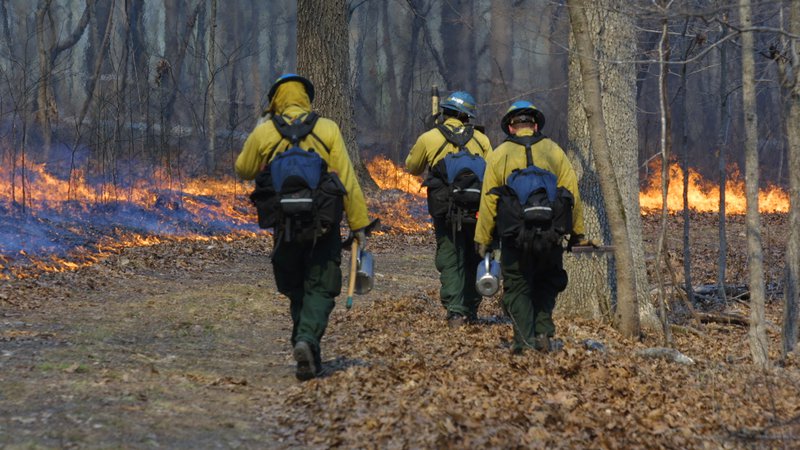Last year, the Arkansas Game and Fish Commission helped improve habitat on 57,221 acres through the use of prescribed fire with only 81 available days when conditions were right to burn. Thanks to new prescribed burn associations forming throughout The Natural State, the AGFC is putting the tools in place to eclipse that amazing tally.
But wildlife populations don’t just exist on managed public land.
According to AGFC Director Austin Booth the habitat quality on private land has even more impact on wildlife populations on a landscape level in Arkansas.
“Only about 10 percent of Arkansas is public land,” Booth said. “If we created picture-perfect habitat on all of that as an agency, we’re still missing 90 percent of the state. That is why we have doubled down on private land habitat with the establishment of a Private Land Habitat Division to focus on this need.”
Old Wisdom, New Lesson
Ted Zawislak, North Arkansas Private Lands Supervisor for the AGFC, says prescribed burn associations are one of many new tools the agency is using to empower landowners who want to improve wildlife habitat on their land. Each group is established through a regional private land biologist and is structured with a president, vice president, secretary, treasurer and board members. Once established, the PBA receives fire training and can apply for a burn trailer and equipment provided in partnership by the AGFC, Quail Forever, Arkansas Forestry Division of the Arkansas Department of Agriculture and United States Fish and Wildlife Service.
On the surface, prescribed burn associations seem like a new take on the wisdom of community-based work seen in Amish barn-raisings. The adage “Many hands make light work,” comes up a bit short of the benefits you find in PBAs.
“PBAs don’t just share the workload labor-wise,” Zawislak said. “They share knowledge, experience and even tools in addition to muscle power. Everyone in the PBA sees the benefits of prescribed burns in a less intimidating, more effective effort.”
Catching Fire
Prescribed burn associations have proven successful in many states surrounding Arkansas. According to John Weir, research associate at Oklahoma State University’s Department of Natural Resource Ecology and Management, there are roughly 113 PBAs spread across 19 states conducting prescribed burns on private and public land. Those numbers grow each year.
According to Zawislak, AGFC biologists contacted Weir to get info on expanding these programs to Arkansas. Oklahoma’s associations have been at work for nearly a decade. From 2015 to 2020, they performed 591 operations and improved 133,587 acres of wildlife habitat with prescribed burns.
“We didn’t want to reinvent the wheel,” Zawislak said. “Oklahoma has a healthy PBA network with several groups participating in their state. Weir’s advice shortened the learning curve for us tremendously, as did the input from many of our established partners here in Arkansas.”
Laurie Gaines, current president of the Central Arkansas PBA, the first one established in Arkansas, has gone from intimidation to implementation of fire in less than a year thanks to the knowledge and help of the group. She credits Maia Larson, previous president of the PBA, with getting things off the ground and running.
“I’ve gone from, ‘Oh my gosh, can I burn this ditch full of leaves without panicking?’ to being able to create fire lanes and coordinate a team of volunteers to make larger prescribed burns happen.”
Sparked Interest
Gaines initially learned about prescribed fire through a chance meeting with Morgan Meador, a Farm Bill biologist with Quail Forever.
“Once I learned how fire has been used for centuries to manage habitat, and I realized it was something I wanted to do with my land,” Gaines said. “I took the ‘Learn To Burn’ classes offered through AGFC and Quail Forever, which were fantastic. But the association is how you’re able to get the manpower, tools and equipment to be successful with prescribed burns.”
Gaines says the central Arkansas PBA is still relatively small, but the motivations to join are extremely diverse. Some landowners are wanting to use fire to clear out vines, shrubs and tangles trying to take over some wooded areas, others are looking to increase the amount of turkey and quail habitat on their property.
“We just conducted a burn in December to clear off an area where a member is trying to reestablish wildflowers,” Gaines said. “Me, I’m just looking to improve my 40 acres for wildlife and make it where it’s easier to walk and ride an ATV to enjoy the property more. But to do that, I know I need more than just myself, you need a network of friends, and so do they.”
Managing Lanes
Gaines says her PBA is always looking for new members, but there’s still a lot of need for more PBAs throughout the state.
“You don’t want to get too large, logistics-wise,” Gaines said. “If members are more than a county or two away from each other, they may not be able to participate in burns. You also need to be within driving distance to pick up the trailers AGFC, Quail Forever and the Fish and Wildlife Service loan out once you’ve met their training criteria.”
Zawislak hopes the program’s momentum has begun to pick up steam. In 2021, only two groups existed, but they burned 148 acres on private land. In 2022, the program expanded to four groups and managed burns on 435 acres. Now Zawislak says seven PBAs have taken root, including groups in south Arkansas and the Arkansas River Valley.
“Taking away confusion and intimidation of using fire as a tool is key,” Zawislak said. “Someday you hope you can leave and they will stand on their own. I have personally burned with these groups and have seen firsthand how people who were once scared of using fire have become so proficient that I would trust them to burn my own property.”
Learn more about joining a PBA or forming a new group at www.agfc.com/habitat. People in central Arkansas can also contact Gaines at [email protected].






